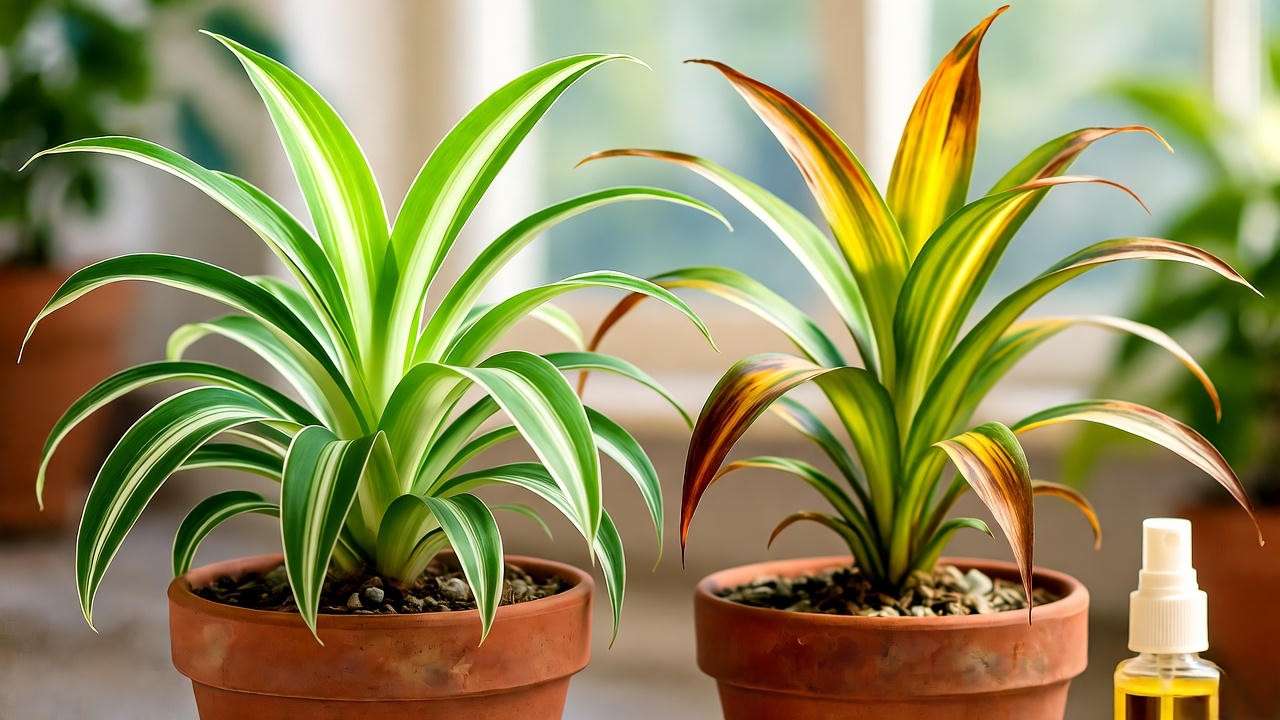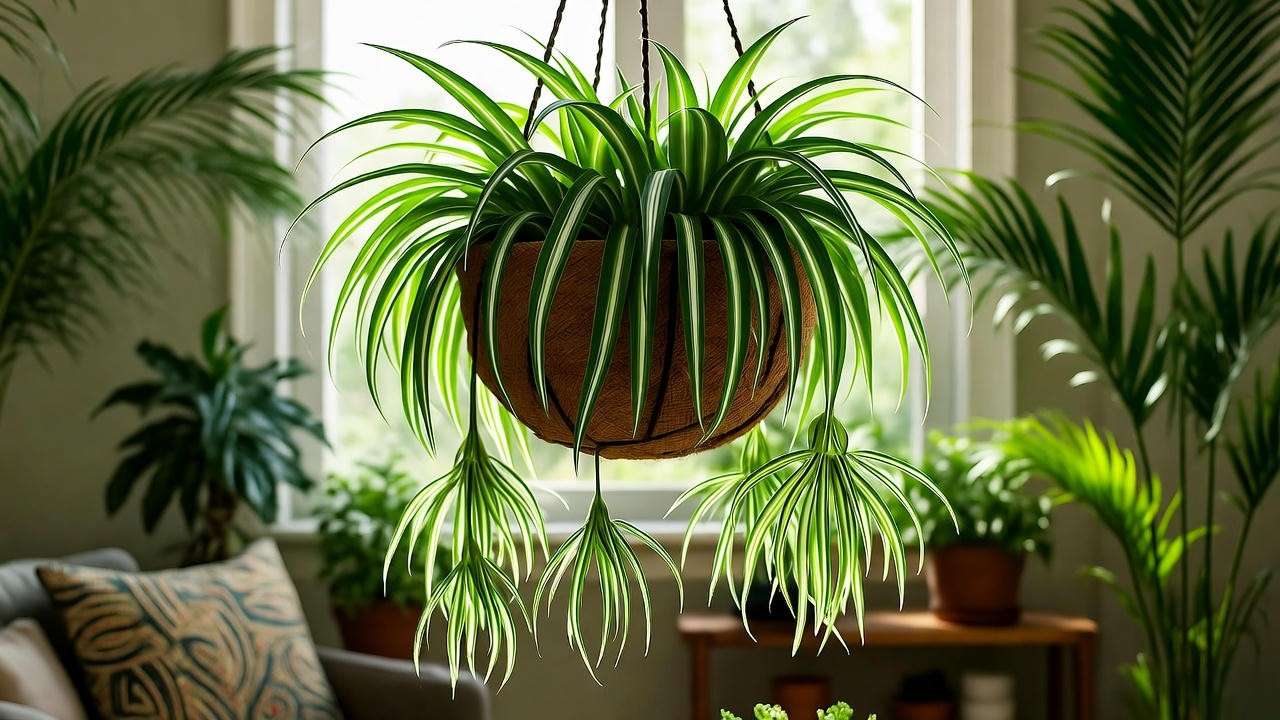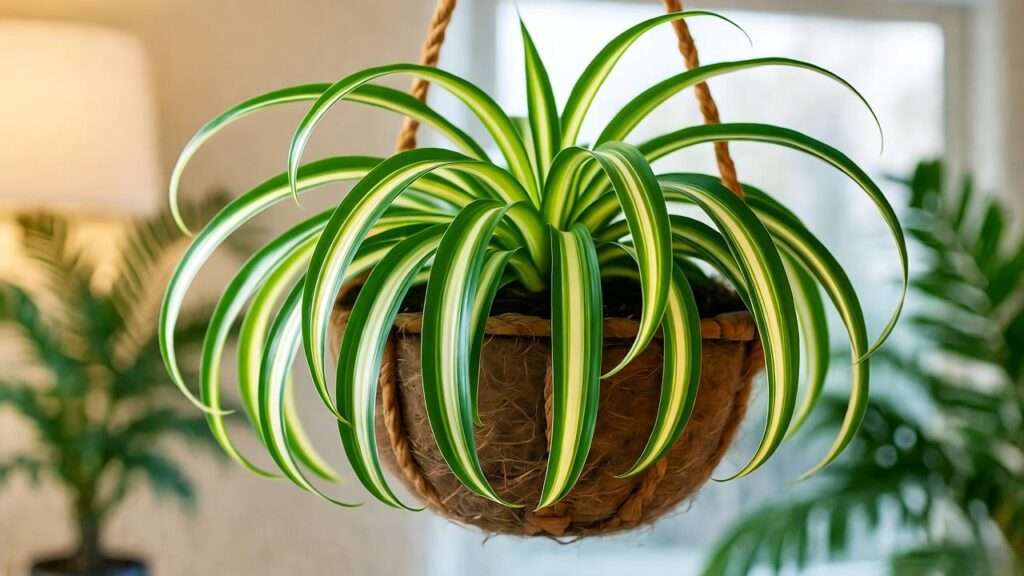Picture this: a lush, cascading plant with vibrant green-and-cream leaves, effortlessly brightening your home while purifying the air. Meet the Spider Plant Hawaiian (Chlorophytum comosum ‘Hawaiian’), a tropical stunner that’s as easy to care for as it is beautiful! 🌱 Whether you’re a beginner or a seasoned plant parent, this guide will empower you to grow a thriving Hawaiian Spider Plant. From light and watering tips to propagation and troubleshooting, we’ve got everything you need to keep this low-maintenance gem flourishing. Let’s dive into the world of this air-purifying, pet-friendly houseplant and transform your space with its tropical charm! 😊
As a plant care enthusiast with years of experience nurturing Chlorophytum varieties, I’ve seen firsthand how the Hawaiian Spider Plant’s unique curly foliage and forgiving nature make it a favorite. Backed by insights from horticultural experts and studies like NASA’s Clean Air Study, this article is your go-to resource for mastering its care. By the end, you’ll have a clear, actionable plan to ensure your plant thrives for years to come. 🌿
What Makes the Hawaiian Spider Plant Special? 🌺
The Spider Plant Hawaiian isn’t just another houseplant—it’s a statement piece with a tropical twist. Let’s explore what sets it apart and why it deserves a spot in your home.
Unique Characteristics of the Hawaiian Spider Plant
Unlike the classic spider plant with its straight, arching leaves, the Hawaiian variety boasts curly, variegated foliage in vibrant green with creamy-white stripes. Its compact size—typically 12–18 inches tall and wide—makes it perfect for small spaces like apartments, offices, or cozy corners. 🏠 According to NASA’s Clean Air Study, spider plants excel at removing indoor air pollutants like formaldehyde, making the Hawaiian variety a functional and stylish addition to any space. Its dangling “spiderettes” (baby plantlets) add a playful, cascading effect, earning it the nickname “airplane plant.” ✈️
Why Choose the Hawaiian Spider Plant?
This plant is a dream for busy plant lovers. It’s low-maintenance, forgiving of occasional neglect, and safe for pets, as confirmed by the ASPCA. 🐾 Its tropical aesthetic pairs beautifully with modern or bohemian decor, instantly elevating your space. Plus, it thrives indoors or in shaded outdoor areas in warm climates (USDA zones 9–11). Whether you’re looking to purify your air, add greenery to a small space, or propagate new plants to share, the Hawaiian Spider Plant delivers.
Comparison Table: Hawaiian Spider Plant vs. Other Varieties
| Variety | Leaf Shape | Size | Care Difficulty |
|---|---|---|---|
| Hawaiian | Curly, green/cream | Compact (12–18 in) | Easy |
| Vittatum | Straight, green/white | Larger (18–24 in) | Easy |
| Bonnie | Curly, green/white | Compact (12–18 in) | Easy |
This table highlights why the Hawaiian variety’s compact, curly leaves make it a unique choice for plant enthusiasts.
Essential Care Requirements for a Thriving Hawaiian Spider Plant 🌞
Caring for your Hawaiian Spider Plant is simple when you understand its basic needs. Let’s break down the essentials: light, water, soil, and environmental conditions.
Light Needs for Optimal Growth
The Hawaiian Spider Plant thrives in bright, indirect light, which enhances its vibrant variegation. Place it near an east- or west-facing window, where it gets filtered sunlight. 💡 It can tolerate low light, but prolonged dim conditions may fade its creamy stripes. Avoid direct sunlight, as it can scorch the leaves, causing brown, crispy edges. If natural light is limited, a grow light (10–12 hours daily) works wonders.
Pro Tip: Rotate your plant every few weeks to ensure even growth and prevent it from leaning toward the light.
Watering the Hawaiian Spider Plant
Watering is where many plant parents stumble, but it’s easy to get right. Keep the soil lightly moist, watering when the top inch feels dry—typically every 7–10 days in spring and summer. In winter, reduce watering to every 2–3 weeks, as the plant’s growth slows. ❄️ Overwatering is the top cause of issues like yellowing leaves or root rot, while underwatering leads to droopy, lackluster foliage. Use room-temperature water, and if your tap water is high in fluoride or chlorine, consider distilled water to prevent brown leaf tips.
Personal Anecdote: I once overwatered my Hawaiian Spider Plant, leaving it in soggy soil for weeks. The leaves turned yellow, but by adjusting my watering routine and repotting it in fresh, well-draining soil, I nursed it back to health in a month!
Soil and Potting Requirements
A well-draining potting mix is key to a happy Hawaiian Spider Plant. Combine standard potting soil with perlite or sand (a 2:1 ratio works well) to ensure proper drainage. Choose a pot with drainage holes to prevent water from pooling at the roots. 🪴 Repot every 1–2 years or when the plant becomes root-bound (roots circling the pot’s interior). Spring is the best time for repotting, as the plant is actively growing.
Repotting Steps:
- Gently remove the plant from its pot.
- Shake off excess soil and trim any damaged roots.
- Place in a slightly larger pot with fresh soil mix.
- Water lightly and keep in indirect light for a week.

Temperature and Humidity
The Hawaiian Spider Plant prefers temperatures between 60–75°F (15–24°C), making it ideal for most homes. Protect it from cold drafts, air conditioners, or heaters, which can stress the plant. While it tolerates average household humidity (30–50%), it loves a boost from occasional misting, especially in dry climates or winter months. 💦 If you notice brown leaf tips, try placing a humidity tray (a shallow dish with pebbles and water) near the plant.
Winter Care Tip: Keep your plant away from windowsills at night if temperatures drop below 50°F (10°C).
How to Propagate Your Hawaiian Spider Plant 🌱
One of the joys of owning a Hawaiian Spider Plant is its ability to produce adorable spiderettes—perfect for expanding your collection or gifting to friends. Here’s how to propagate successfully.
Propagating Through Spiderettes (Plantlets)
Spiderettes are the baby plants that dangle from long stalks, ready to root and grow. Here’s a step-by-step guide:
- Identify Healthy Spiderettes: Choose plantlets with small roots forming at the base.
- Cut or Keep Attached: Snip the spiderette from the mother plant or leave it attached for rooting (it draws nutrients from the parent).
- Rooting Options:
- Water Propagation: Place the spiderette in a jar of water, ensuring only the roots touch the liquid. Change water every 3–5 days. Roots should develop in 1–2 weeks. 💧
- Soil Propagation: Plant the spiderette directly in moist, well-draining soil. Keep the soil lightly moist and place in indirect light.
- Transplant: Once roots are 1–2 inches long, transfer water-rooted spiderettes to soil or care for soil-rooted ones as mature plants.
Best Time: Propagate in spring or summer for faster rooting.

Dividing Mature Plants
If your Hawaiian Spider Plant is overcrowded, division is a great way to rejuvenate it.
- Check for Root-Bound Signs: Roots circling the pot or emerging from drainage holes.
- Divide Carefully: Remove the plant, gently separate the root ball into sections, ensuring each has roots and foliage.
- Repot: Plant each section in a new pot with fresh soil mix. Water lightly and keep in indirect light for 2–3 weeks.
Visual Aid Idea: Include a step-by-step infographic showing water vs. soil propagation for visual learners.
Troubleshooting Common Hawaiian Spider Plant Problems 🐞
Even with the best care, issues can arise. Here’s how to diagnose and fix common problems to keep your plant thriving.
Brown Leaf Tips
Causes:
- Overwatering or poor drainage.
- Low humidity, especially in dry climates.
- Fluoride or chlorine buildup from tap water.
Solutions:
- Check soil moisture and ensure proper drainage.
- Increase humidity with misting or a humidity tray.
- Switch to distilled or filtered water to reduce chemical buildup.

Yellowing or Drooping Leaves
Causes:
- Overwatering (soggy soil) or underwatering (dry, crispy leaves).
- Insufficient light, causing weak growth.
- Nutrient deficiency from lack of fertilization.
Solutions:
- Adjust watering to keep soil lightly moist.
- Move to a brighter spot with indirect light.
- Fertilize monthly during the growing season with a diluted, balanced fertilizer.
Pest Issues
Hawaiian Spider Plants are generally pest-resistant but may attract spider mites, aphids, or mealybugs.
- Signs: Webbing, sticky residue, or white cottony spots on leaves. 🕷️
- Prevention: Regularly wipe leaves with a damp cloth and maintain good air circulation.
- Treatment: Spray with neem oil or insecticidal soap, repeating every 5–7 days until pests are gone.
Downloadable Resource: Offer a free checklist for diagnosing and treating common issues to boost engagement and provide value.
Fertilizing and Boosting Growth 🌿
To keep your Hawaiian Spider Plant lush and vibrant, proper fertilization and growth-enhancing techniques are essential. This section covers how to nourish your plant and encourage its signature cascading spiderettes.
When and How to Deuteronomy
Fertilizing your Hawaiian Spider Plant correctly ensures healthy growth without overwhelming it. Use a balanced, water-soluble fertilizer (e.g., 10-10-10 or 20-20-20) diluted to half-strength to avoid overfeeding.
- Frequency: Apply fertilizer once a month during the growing season (spring and summer). Avoid fertilizing in fall and winter when the plant’s growth slows. 🍂
- Application: Mix the fertilizer with water and apply it to moist soil to prevent root burn.
- Organic Options: For eco-conscious plant parents, consider organic alternatives like compost tea or fish emulsion, which provide gentle nutrients.
Expert Tip: Over-fertilizing can cause brown leaf tips or stunted growth. Always err on the side of less fertilizer, especially for this low-maintenance plant.
Encouraging Lush Foliage and Spiderettes
To promote abundant foliage and spiderette production:
- Provide Adequate Light: Bright, indirect light encourages vibrant leaves and plantlet growth.
- Prune Sparingly: Trim dead or yellowing leaves to redirect energy to new growth. Use clean, sharp scissors to avoid damage. ✂️
- Maintain Nutrient Balance: Regular fertilization supports the energy needed for spiderette production.
Expert Insight: Horticultural studies show that spider plants produce more plantlets under optimal light and nutrient conditions, so consistency is key. I’ve noticed my Hawaiian Spider Plant produces dozens of spiderettes in spring when I place it near a bright window and fertilize monthly.
Styling Your Hawaiian Spider Plant in Home Decor 🏡
The Hawaiian Spider Plant’s curly, cascading leaves make it a versatile decor piece. Here’s how to showcase its tropical beauty and enhance your space.
Creative Display Ideas
- Hanging Baskets: Let the spiderettes cascade freely for a dramatic effect. Choose macramé or ceramic baskets for style.
- Tabletop Arrangements: Place in colorful or textured pots to complement modern or bohemian aesthetics. 🪴
- Plant Pairings: Combine with other tropical plants like pothos or peace lilies for a lush, jungle-inspired corner. 🌴
Design Tip: Use a decorative tray or stand to elevate your plant, drawing attention to its unique foliage.

Feng Shui and Wellness Benefits
In Feng Shui, the Hawaiian Spider Plant is believed to promote positive energy and harmony when placed in living rooms, offices, or bedrooms. Its air-purifying qualities contribute to a healthier indoor environment, potentially reducing stress and improving focus. 😊 Studies, like those from the University of Georgia, suggest that caring for houseplants can boost mental well-being, making this plant a perfect addition to your self-care routine.
Engagement Booster: Encourage readers to share their Hawaiian Spider Plant setups on social media with a hashtag like #HawaiianSpiderPlantGoals to build community and increase engagement.
Frequently Asked Questions (FAQs) ❓
To address common queries and target long-tail keywords for SEO, here are answers to popular questions about the Hawaiian Spider Plant.
- Q1: Is the Hawaiian Spider Plant safe for pets? Yes, it’s non-toxic to cats and dogs, according to the ASPCA, making it a safe choice for pet-friendly homes. 🐶
- Q2: How often should I repot my Hawaiian Spider Plant? Repot every 1–2 years or when roots are crowded, typically in spring. Use a pot 1–2 inches larger to accommodate growth.
- Q3: Why isn’t my plant producing spiderettes? Insufficient light or nutrients are common culprits. Ensure bright, indirect light and fertilize monthly during spring and summer.
- Q4: Can the Hawaiian Spider Plant grow outdoors? Yes, in USDA zones 9–11, it thrives in shaded outdoor areas. Protect from direct sun and bring indoors if temperatures drop below 50°F (10°C).
SEO Note: These FAQs target voice search queries like “Is the Hawaiian Spider Plant pet-safe?” and enhance Google Discover visibility by addressing user needs directly.
Fun Facts About the Hawaiian Spider Plant 🌟
Here’s some delightful trivia to deepen your appreciation for this charming plant:
- Not from Hawaii: Despite its name, the Hawaiian Spider Plant is native to South Africa. Its tropical vibe inspired the name.
- Historical Uses: In some African cultures, spider plants were used for medicinal purposes, like treating minor wounds.
- Nickname Origins: The dangling spiderettes resemble tiny parachutes, earning the plant its “airplane plant” nickname. ✈️
Engagement Idea: Add a fun poll, such as “What’s your favorite spider plant variety?” to increase time-on-page and user interaction.
Conclusion: Your Journey to a Thriving Hawaiian Spider Plant 🌿
The Hawaiian Spider Plant is more than just a houseplant—it’s a low-maintenance, air-purifying, and visually stunning addition to your home. By providing bright, indirect light, consistent watering, well-draining soil, and occasional fertilization, you’ll enjoy lush foliage and cascading spiderettes for years. Whether you’re propagating new plants, troubleshooting brown tips, or styling it in a hanging basket, this guide equips you with expert-backed strategies to succeed.
Start small, experiment with propagation, and let your Hawaiian Spider Plant transform your space with its tropical charm. Share your plant journey in the comments or explore our related guides, like “Top 10 Air-Purifying Plants” or “Beginner’s Guide to Houseplant Care,” for more inspiration. 🌱













